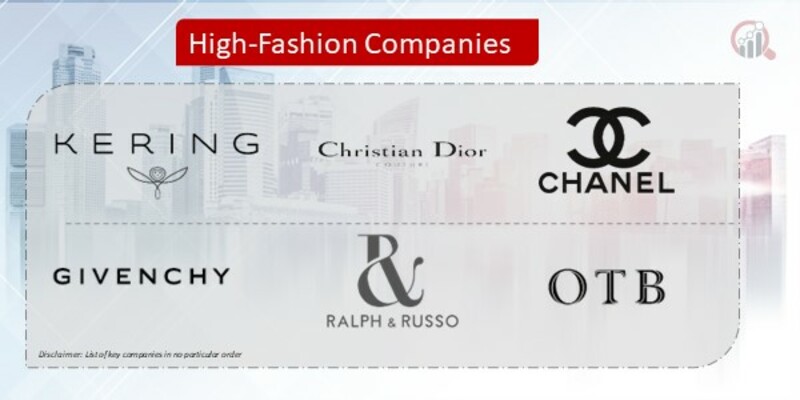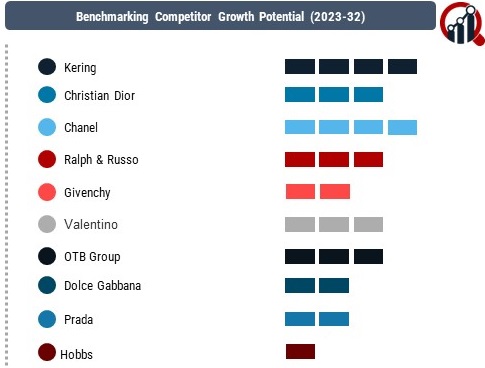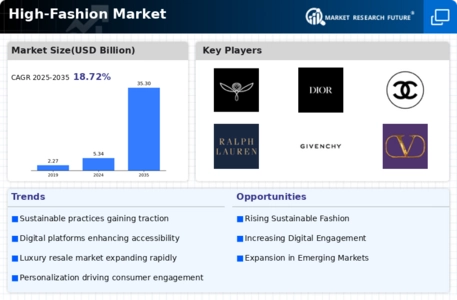Top Industry Leaders in the High-Fashion Market

As the high-fashion market continues to evolve, new and emerging companies are making their mark, introducing innovative designs and addressing changing consumer preferences. Emerging luxury brands such as Off-White and Balenciaga, under the ownership of Kering and LVMH, respectively, have gained prominence by focusing on streetwear influences and cultivating a strong social media presence. These companies often adopt a direct-to-consumer model, emphasizing digital commerce and online brand engagement. The industry is witnessing a shift towards sustainability, prompting new entrants to prioritize eco-conscious practices, from sourcing materials to manufacturing processes.
Industry news within the high-fashion market reflects ongoing trends, technological advancements, and societal shifts influencing the luxury fashion sector. News related to fashion weeks, runway shows, and exclusive events showcases efforts to maintain brand allure and set the tone for upcoming trends. Moreover, developments in sustainable practices, ethical sourcing, and diversity and inclusion initiatives are frequently covered in industry news, aligning with the growing emphasis on responsible and inclusive luxury practices. The market also responds to global events and cultural changes, with news covering topics such as the impact of the COVID-19 pandemic on fashion consumption and the industry's response to calls for greater transparency.
Current investment trends in the high-fashion industry underscore a dual focus on digital transformation and sustainability initiatives. Key players are directing investments towards enhancing e-commerce capabilities, adopting advanced analytics for consumer insights, and exploring virtual and augmented reality for immersive shopping experiences. Investments in sustainable practices, from circular fashion models to environmentally friendly packaging, are prevalent, reflecting a commitment to addressing environmental concerns. Additionally, strategic investments in influencer marketing, social media engagement, and experiential retail concepts are notable trends as companies seek to build emotional connections with consumers and adapt to the changing retail landscape.
The overall competitive scenario in the high-fashion market is characterized by established luxury brands and emerging disruptors, each navigating the industry with distinct strategies. Market share analysis considers factors such as brand prestige, design innovation, and responsiveness to evolving fashion preferences. The industry's responsiveness to sustainability, inclusivity, and the integration of technology further shapes competitiveness. As consumers increasingly seek meaningful brand connections, value transparency, and demand sustainable practices, the high-fashion market is poised for continued evolution, with companies striving to balance exclusivity, innovation, and ethical considerations.
In conclusion, the high-fashion market's competitiveness is driven by a mix of established luxury houses and innovative newcomers. Key players strategically position themselves through brand prestige, design innovation, and exclusive collaborations. New entrants leverage streetwear influences, digital commerce, and sustainability to carve out their niche. Industry news reflects the dynamic nature of the market, responding to trends, technological advancements, and societal shifts. Current investment trends emphasize digital transformation, sustainability, and a customer-centric approach. The overall competitive scenario underscores the importance of adaptability, innovation, and a nuanced understanding of the multifaceted factors influencing the high-fashion market.
Industry News and Investment Landscape
- Current industry acquisitions (LVMH's acquisition of Tiffany & Co.) and recent initial public offerings (IPOs) by luxury companies like Capri Holdings (Versace) demonstrate the optimistic investor attitude toward the high-end fashion business.
- A focus on potential growth areas is shown by increased spending in digital marketing efforts, online platforms, and sustainable supply chain initiatives.
- Growing celebrity and influencer influence on social media sites like TikTok and Instagram is important for consumer trends and brand recognition.
Key Companies in the High-Fashion Market Include
- Kering
- Christian Dior
- Chanel
- Ralph & Russo
- Givenchy
- Valentino
- OTB Group
- Dolce Gabbana
- Prada
- Hobbs
- Burberry
- Calvin Klein
- Armani
- Versace
- Hermes










